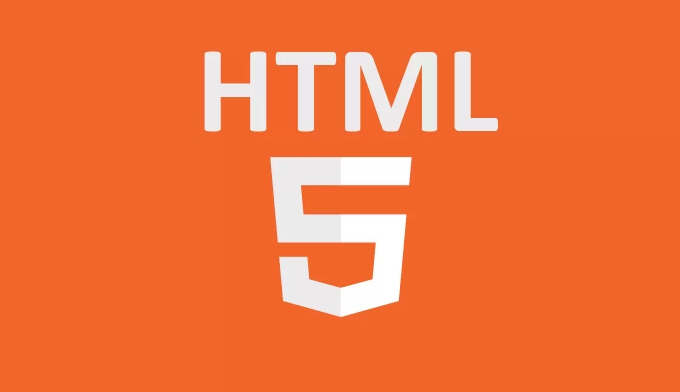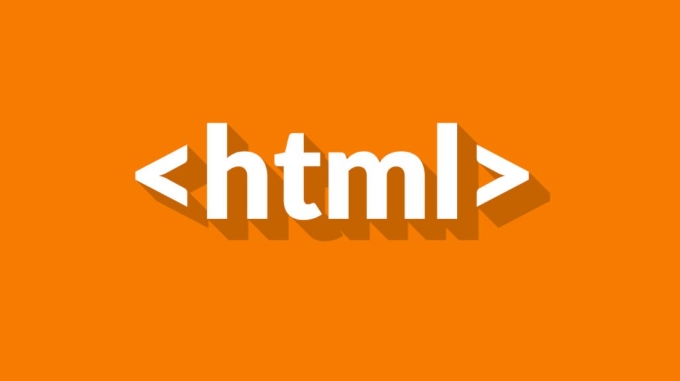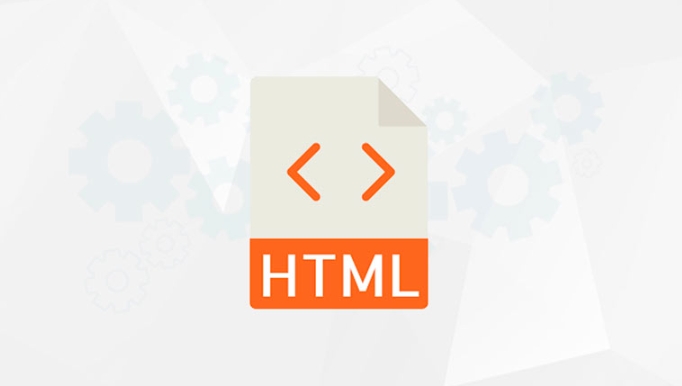How to implement ARIA roles for better HTML accessibility
Aug 04, 2025 pm 01:10 PMAlways use semantic HTML elements like <button> instead of adding ARIA roles to non-semantic elements like

Adding ARIA (Accessible Rich Internet Applications) roles to your HTML is a powerful way to improve accessibility for users who rely on screen readers and other assistive technologies. While semantic HTML should always come first, ARIA fills the gaps when native elements aren’t enough—like in custom widgets or dynamic content. Here’s how to implement ARIA roles effectively and safely.

1. Use Semantic HTML First, Then ARIA
Before adding any ARIA roles, ask: Can I use a native HTML element instead?
Buttons, links, headings, lists, and form controls have built-in accessibility. Overriding them with ARIA can do more harm than good.
? Do this:

<button>Submit</button>
? Not this:
<div role="button">Submit</div>
Native <button> has keyboard focus, click behavior, and screen reader recognition by default. The div with role="button" lacks all that unless you manually add event handlers and tabindex.

Rule of thumb: Use ARIA only when you can’t achieve the desired accessible behavior with standard HTML.
2. Apply ARIA Roles to Enhance Meaning
ARIA roles define what an element is or does. They help screen readers interpret dynamic or non-standard components.
Common roles include:
role="navigation"– for navigation sectionsrole="main"– for the primary content arearole="banner"– for site headersrole="complementary"– for sidebarsrole="contentinfo"– for footers
Example:
<header role="banner">
<nav role="navigation">
<ul>
<li><a href="/">Home</a></li>
<li><a href="/about">About</a></li>
</ul>
</nav>
</header>
<main role="main">
<h1>Welcome</h1>
<p>Page content goes here.</p>
</main>
<aside role="complementary">
<h2>Related Links</h2>
<ul>...</ul>
</aside>
<footer role="contentinfo">
<p>© 2024 Company</p>
</footer>Note: Many of these roles are now implied by HTML5 semantic elements (e.g., <nav> already has role="navigation"), so they’re often redundant—but harmless if used.
3. Use ARIA for Custom Widgets (With Care)
When building custom UI components—like tabs, dropdowns, or modals—you’ll need ARIA to make them accessible.
Example: Custom Tab Panel
<div role="tablist"> <button role="tab" aria-selected="true" aria-controls="panel-1">Tab 1</button> <button role="tab" aria-selected="false" aria-controls="panel-2">Tab 2</button> </div> <div id="panel-1" role="tabpanel" aria-labelledby="tab-1"> Content for Tab 1 </div> <div id="panel-2" role="tabpanel" aria-labelledby="tab-2" hidden> Content for Tab 2 </div>
Key ARIA attributes used:
role="tablist"– container for tabsrole="tab"– individual tab (must be keyboard focusable)aria-selected– indicates active tabaria-controls– links tab to its panelrole="tabpanel"– holds tab contenthidden– hides inactive panels
?? You must also handle keyboard navigation (e.g., Arrow keys, Enter) and update ARIA states via JavaScript.
4. Manage Dynamic Content with Live Regions
When content updates dynamically (e.g., form errors, notifications), use ARIA live regions so screen readers can announce changes.
<div aria-live="polite" aria-atomic="true" id="status-message"> <!-- Messages inserted here will be read --> </div>
aria-live="polite"– queues the message when the user is idlearia-live="assertive"– interrupts for urgent messages (use sparingly)aria-atomic="true"– reads the entire region when any part changes
Example use:
document.getElementById('status-message').textContent = 'Item added to cart.';Screen readers will announce the update automatically.
5. Avoid Common ARIA Mistakes
Even well-intentioned ARIA can hurt accessibility if misused.
? Don’t:
- Use
role="button"on non-interactive elements without making them keyboard accessible - Add ARIA roles to elements that already have implicit roles (e.g.,
) - Use generic
divorspanwith ARIA when a semantic element exists - Forget to manage focus in modals or dynamic content
- Use
aria-hidden="true"on focusable elements (confuses screen reader users)
? Do:
- Test with screen readers (e.g., NVDA, VoiceOver)
- Use browser dev tools to inspect ARIA and accessibility tree
- Follow WAI-ARIA Authoring Practices for complex widgets
ARIA is a powerful tool, but it’s not a substitute for good HTML structure and keyboard support. Use it to enhance, not replace, accessibility fundamentals.
Basically: HTML first, ARIA when needed, and always test.
The above is the detailed content of How to implement ARIA roles for better HTML accessibility. For more information, please follow other related articles on the PHP Chinese website!

Hot AI Tools

Undress AI Tool
Undress images for free

Undresser.AI Undress
AI-powered app for creating realistic nude photos

AI Clothes Remover
Online AI tool for removing clothes from photos.

Clothoff.io
AI clothes remover

Video Face Swap
Swap faces in any video effortlessly with our completely free AI face swap tool!

Hot Article

Hot Tools

Notepad++7.3.1
Easy-to-use and free code editor

SublimeText3 Chinese version
Chinese version, very easy to use

Zend Studio 13.0.1
Powerful PHP integrated development environment

Dreamweaver CS6
Visual web development tools

SublimeText3 Mac version
God-level code editing software (SublimeText3)
 Applying Semantic Structure with article, section, and aside in HTML
Jul 05, 2025 am 02:03 AM
Applying Semantic Structure with article, section, and aside in HTML
Jul 05, 2025 am 02:03 AM
The rational use of semantic tags in HTML can improve page structure clarity, accessibility and SEO effects. 1. Used for independent content blocks, such as blog posts or comments, it must be self-contained; 2. Used for classification related content, usually including titles, and is suitable for different modules of the page; 3. Used for auxiliary information related to the main content but not core, such as sidebar recommendations or author profiles. In actual development, labels should be combined and other, avoid excessive nesting, keep the structure simple, and verify the rationality of the structure through developer tools.
 Implementing Clickable Buttons Using the HTML button Element
Jul 07, 2025 am 02:31 AM
Implementing Clickable Buttons Using the HTML button Element
Jul 07, 2025 am 02:31 AM
To use HTML button elements to achieve clickable buttons, you must first master its basic usage and common precautions. 1. Create buttons with tags and define behaviors through type attributes (such as button, submit, reset), which is submitted by default; 2. Add interactive functions through JavaScript, which can be written inline or bind event listeners through ID to improve maintenance; 3. Use CSS to customize styles, including background color, border, rounded corners and hover/active status effects to enhance user experience; 4. Pay attention to common problems: make sure that the disabled attribute is not enabled, JS events are correctly bound, layout occlusion, and use the help of developer tools to troubleshoot exceptions. Master this
 Configuring Document Metadata Within the HTML head Element
Jul 09, 2025 am 02:30 AM
Configuring Document Metadata Within the HTML head Element
Jul 09, 2025 am 02:30 AM
Metadata in HTMLhead is crucial for SEO, social sharing, and browser behavior. 1. Set the page title and description, use and keep it concise and unique; 2. Add OpenGraph and Twitter card information to optimize social sharing effects, pay attention to the image size and use debugging tools to test; 3. Define the character set and viewport settings to ensure multi-language support is adapted to the mobile terminal; 4. Optional tags such as author copyright, robots control and canonical prevent duplicate content should also be configured reasonably.
 Best HTML tutorial for beginners in 2025
Jul 08, 2025 am 12:25 AM
Best HTML tutorial for beginners in 2025
Jul 08, 2025 am 12:25 AM
TolearnHTMLin2025,chooseatutorialthatbalanceshands-onpracticewithmodernstandardsandintegratesCSSandJavaScriptbasics.1.Prioritizehands-onlearningwithstep-by-stepprojectslikebuildingapersonalprofileorbloglayout.2.EnsureitcoversmodernHTMLelementssuchas,
 How to associate captions with images or media using the html figure and figcaption elements?
Jul 07, 2025 am 02:30 AM
How to associate captions with images or media using the html figure and figcaption elements?
Jul 07, 2025 am 02:30 AM
Using HTML sums allows for intuitive and semantic clarity to add caption text to images or media. 1. Used to wrap independent media content, such as pictures, videos or code blocks; 2. It is placed as its explanatory text, and can be located above or below the media; 3. They not only improve the clarity of the page structure, but also enhance accessibility and SEO effect; 4. When using it, you should pay attention to avoid abuse, and apply to content that needs to be emphasized and accompanied by description, rather than ordinary decorative pictures; 5. The alt attribute that cannot be ignored, which is different from figcaption; 6. The figcaption is flexible and can be placed at the top or bottom of the figure as needed. Using these two tags correctly helps to build semantic and easy to understand web content.
 HTML for email templates tutorial
Jul 10, 2025 pm 02:01 PM
HTML for email templates tutorial
Jul 10, 2025 pm 02:01 PM
How to make HTML mail templates with good compatibility? First, you need to build a structure with tables to avoid using div flex or grid layout; secondly, all styles must be inlined and cannot rely on external CSS; then the picture should be added with alt description and use a public URL, and the buttons should be simulated with a table or td with background color; finally, you must test and adjust the details on multiple clients.
 What are the most commonly used global attributes in html?
Jul 10, 2025 am 10:58 AM
What are the most commonly used global attributes in html?
Jul 10, 2025 am 10:58 AM
class, id, style, data-, and title are the most commonly used global attributes in HTML. class is used to specify one or more class names to facilitate style setting and JavaScript operations; id provides unique identifiers for elements, suitable for anchor jumps and JavaScript control; style allows for inline styles to be added, suitable for temporary debugging but not recommended for large-scale use; data-properties are used to store custom data, which is convenient for front-end and back-end interaction; title is used to add mouseover prompts, but its style and behavior are limited by the browser. Reasonable selection of these attributes can improve development efficiency and user experience.
 How to handle forms submission in HTML without a server?
Jul 09, 2025 am 01:14 AM
How to handle forms submission in HTML without a server?
Jul 09, 2025 am 01:14 AM
When there is no backend server, HTML form submission can still be processed through front-end technology or third-party services. Specific methods include: 1. Use JavaScript to intercept form submissions to achieve input verification and user feedback, but the data will not be persisted; 2. Use third-party serverless form services such as Formspree to collect data and provide email notification and redirection functions; 3. Use localStorage to store temporary client data, which is suitable for saving user preferences or managing single-page application status, but is not suitable for long-term storage of sensitive information.






